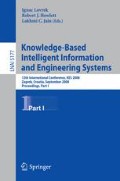Abstract
Adaptive e-learning systems need to get complete learner profile to make efficient personalization. However, learner profile is dispersed over multiple heterogeneous e-learning systems. Unfortunately, these e-learning systems are heterogeneous what makes difficult to get complete learner profile. By using semantic web technology, namely Topic Maps, we show how we perform integration of heterogeneous fragments of learner profile to get more complete one. However, this technology does not consider constraints and is not able to make reasoning. So we use, together with Topic Maps, Description Logics to represent constraints and make reasoning over integrated data.
Access this chapter
Tax calculation will be finalised at checkout
Purchases are for personal use only
Preview
Unable to display preview. Download preview PDF.
References
IEEE Learning Technology Standards Committee (LTSC), Draft Standard for Learning Technology-Public and Private Information (PAPI) for Learners – PAPI Learner. Core Features, Draft 8 (November 2001), http://ltsc.ieee.org
IMS LIP. IMS Learner Information Packagin. In: Jisc, C. (ed.). Standards briefings series (2002)
Conati, C., Gertner, A., Vanlehn, K.: Using Bayesian networks to manage uncertainty in student modeling. Journal of User Modeling and User-Adapted Interaction 12(4), 371–417 (2002)
González1, C., Burguillo, J.C., Lamas, M.: A Qualitative Comparison of techniques for Student Modeling in Intelligent Tutoring Systems. In: 36th ASEE/IEEE Frontiers in Education Conference (2006); [10]. Klyne, G., Carroll, J.: Resource Description Framework (RDF): Concepts and Abstract Syntax, W3C Working Draft 23 (January 2003) (accessed october, 2006), http://www.w3.org/TR/rdf-concepts/
Brickley, D., Guha, R.V.: RDF Vocabulary Description Language 1.0: RDF Schema. W3C Working Draft (January 23, 2003)
Aroyo, L., Dicheva, D.: Aims: Learning and teaching support for www-based education. Int. Journal for Continuing Engineering Education and Life-long Learning (IJCEELL) 11, 152–164 (2001)
Smith, M.K., McGuinness, D., Volz, R., Welty, C.: Web Ontology Language (OWL): Guide Version 1.0. W3C Working Draft (November 4, 2002)
Denaux, R., Dimitrova, V., Aroyo, L.: Integrating open user modeling and learning content management for the semantic web. In: 10th International Conference on User Modeling (2005)
Dolog, P., Schaefer, M.: Learner modeling on the semantic web. In: Proc. of PerSWeb 2005 Workshop, Personalization on the Semantic Web, Edinburgh, UK (July 2005)
ISO/IEC 13250 Topic Maps, Dec ISO/IEC FCD (1999)
Borgida, A., Serafini, L.: Distributed Description Logics: Directed Domain Correspondences in Federated Information Sources. In: Confederated International Conferences DOA, CoopIS and ODBASE 2002, pp. 36–53. Springer, Heidelberg (2002)
Pepper, S., Moore, G.: XML Topic Maps (XTM) 1.0, TopicMaps.Org Authoring Group (2001), http://www.topicmaps.org/xtm/index.html
Fresse, E.: Using Topic Maps for the representation, management and discovery of knowledge, XML Europe (2000); Palais des congrès Paris (2000)
Baader, F., Calvanese, D., McGuiness, D., Nardi, D., Patel-Schneider, P.: Description Logic Handbook - Theory, Implementation and Applications. Cambridge university press, Cambridge (2003)
Cali, A., Calvanese, D., Colucci, S., Di Noia, T., Donini, F.M.: A description logic based approach for matching user profiles. In: Description Logic Workshop (2004)
Von Hessling, A., Kleemann, T., Sinner, A.: Semantic User Profiles and their Applications in a Mobile Environment, Fachberichte Informatik 2-, Universität Koblenz-Landau (2005)
Author information
Authors and Affiliations
Editor information
Rights and permissions
Copyright information
© 2008 Springer-Verlag Berlin Heidelberg
About this paper
Cite this paper
Ouziri, M. (2008). Accessing the Distributed Learner Profile in the Semantic Web. In: Lovrek, I., Howlett, R.J., Jain, L.C. (eds) Knowledge-Based Intelligent Information and Engineering Systems. KES 2008. Lecture Notes in Computer Science(), vol 5177. Springer, Berlin, Heidelberg. https://doi.org/10.1007/978-3-540-85563-7_60
Download citation
DOI: https://doi.org/10.1007/978-3-540-85563-7_60
Publisher Name: Springer, Berlin, Heidelberg
Print ISBN: 978-3-540-85562-0
Online ISBN: 978-3-540-85563-7
eBook Packages: Computer ScienceComputer Science (R0)

